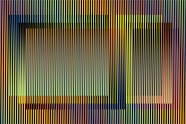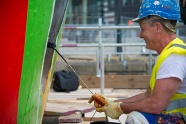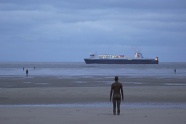Permanent and temporary commissions and projects
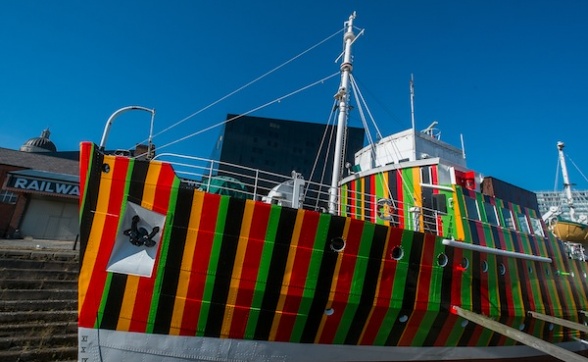
Carlos Cruz-Diez, Induction Chromatique à Double Fréquence pour l’Edmund Gardner Ship / Liverpool. Paris, 2014. Photograph by Mark McNulty.
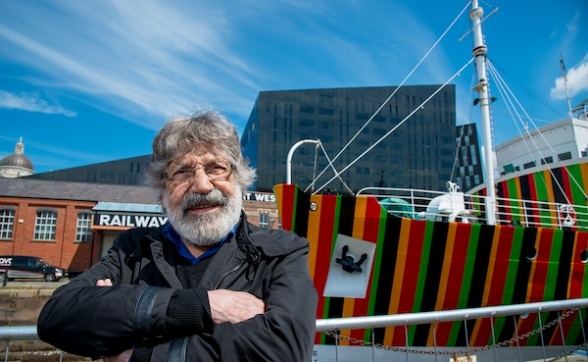
Carlos Cruz-Diez, Induction Chromatique à Double Fréquence pour l’Edmund Gardner Ship / Liverpool. Paris, 2014. Photograph by Mark McNulty.
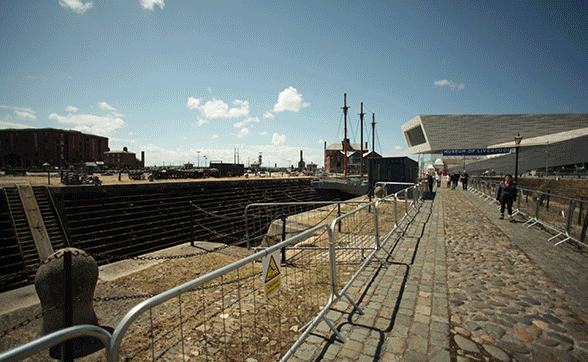
360° view of Carlos Cruz Diez's Dazzle Ship in Liverpool
Carlos Cruz-Diez, Induction Chromatique à Double Fréquence pour l’Edmund Gardner Ship / Liverpool. Paris, 2014. Photograph by Mark McNulty.
Induction Chromatique à Double Fréquence pour l’Edmund Gardner Ship / Liverpool. Paris, 2014
Liverpool Biennial, Tate Liverpool and 14-18 NOW have jointly commissioned Carlos Cruz-Diez to work with the idea of ‘dazzle’ camouflage in partnership with National Museums Liverpool using a historic pilot ship owned and conserved by Merseyside Maritime Museum. The Edmund Gardner is situated in a dry dock adjacent to Liverpool’s Albert Dock and this will be a new public monument for the city.
Dazzle painting was a system for camouflaging ships that was introduced in early 1917, at a time when German submarines were threatening to cut off Britain’s trade and supplies. The idea was not to 'hide' the ships, but to paint them in such a way that their appearance was optically distorted, so that it was difficult for a submarine to calculate the course the ship was travelling on, and so know from what angle to attack. The dazzle was achieved by painting the ship in contrasting stripes and curves that broke up its shape. Characterised by garish colours and a sharp patchwork design of interlocking shapes, the spectacular ‘dazzle’ style was heavily indebted to Cubism.
Dazzle painting was invented by a marine painter, Norman Wilkinson, a future President of the Royal Institute of Painters in Watercolours. Artist Edward Wadsworth, who supervised the application of ‘dazzle’ patterning to over 2,000 ships, later made a series of paintings on the subject.Though the practice has largely (but not entirely) fallen out of fashion in the military, ‘dazzle’ remains a source of inspiration to artists today.
Timelapse: Dazzle Ship from Liverpool Biennial on Vimeo.
Couleur Additive Liverpool ONE, Liverpool. Paris, 2014
Couleur Additive Liverpool ONE, Liverpool. Paris, 2014 by Carlos Cruz-Diez was a temporary artwork co-commissioned by Liverpool Biennial and Liverpool ONE. It spanned Thomas Steers Way and linked Liverpool ONE to Liverpool Biennial’s Dazzle Ship commission, Induction Chromatique à Double Fréquence pour l’Edmund Gardner Ship/ Liverpool. Paris, 2014.
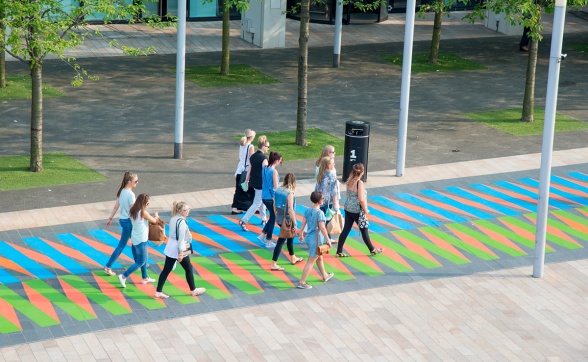
Carlos Cruz-Diez. Couleur Additive Liverpool ONE, Liverpool. Paris, 2014. Photograph by Mark McNulty.
The ‘crosswalk’ was realised as part of Carlos Cruz-Diez’s research into finding new ways of perceiving the chromatic world. He says: ‘The works I create in urban environments and habitats are conceived as artistic statements, creating unforeseen situations and chromatic events in constant mutation, that change the dialectic between the viewer and the work. They are supports for an evolving, changing event.’
Franco-Venezuelan artist Carlos Cruz-Diez is one of the great figures of contemporary art, especially kinetic-optic art. Known for his experiments with light, movement, and especially colour, spanning a career of more than 60 years, his artistic roots reach back to the Movimiento Cinético (Kinetic Movement) of the 1950s and 1960s. As his thinking on the visual arts has evolved, his ideas have changed attitudes on how colour is perceived in art. Cruz-Diez’s intense interest in the properties and possibilities of colour began when he worked as a graphic artist for an advertising agency in Caracas. Rather than using colour in order to define the form of recognisable objects, Cruz-Diez wants to make colour the most important aspect of the work of art, stripping it to its bare essentials. He makes art with which the viewer can interact and which stimulates the senses in a very direct way.
Supported by the National Lottery through the Heritage Lottery Fund and Arts Council England, Bloomberg and Weightmans LLP.
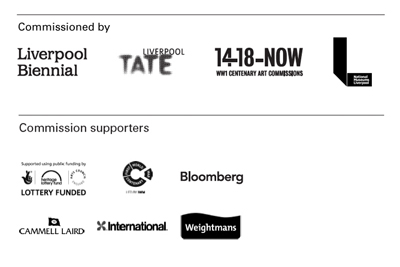
Dazzle Ship
Canning Graving Dock
Liverpool Waterfront
L3 1DG
Liverpool Biennial
55 New Bird Street
Liverpool L1 0BW
- T +44 (0)151 709 7444
- info@biennial.com
Liverpool Biennial is funded by
Founding Supporter
James Moores
